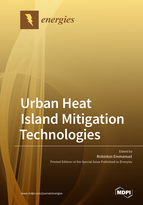Urban Heat Island Mitigation Technologies
A special issue of Energies (ISSN 1996-1073). This special issue belongs to the section "B: Energy and Environment".
Deadline for manuscript submissions: closed (20 November 2020) | Viewed by 20326
Special Issue Editor
Interests: urban heat islands; thermal comfort in the outdoors; climate change and microclimate; sustainable cities; carbon management in the built environment
Special Issues, Collections and Topics in MDPI journals
Special Issue Information
Dear Colleagues,
This special issue of Energies is intended to highlight recent practice and policy developments in the area of urban heat island mitigation. Given the traction climate change mitigation and adaptation currently enjoys in the public imagination and the role of cities in such mitigation, now is the opportune moment to highlight what works and why and to explore the policy and practical implications of both urban design and urban planning.
While it is true that the effect of urban form on local climate has been studied extensively in the last 50 years or so, deliberate design interventions to harness theoretical knowledge on climate-sensitive design in large (urban and neighborhood) scales remain few and far between. This is especially the case in the warm, humid regions of the world, where much of the unintended climate consequences of urbanization are highly negative and interventions to mitigate them are exceedingly rare.
We therefore invite researchers and practitioners to explore key issues in the following areas of urban heat island mitigation:
- Building design—layout and design features that maximise energy efficiency and thermal comfort without compromising the ability of other buildings to enjoy similar benefits; the use of interstitial spaces (piazzas, streets, and parks) to improve the microclimate at the neighbourhood-level;
- Design interventions—case studies with pre- and post-intervention measurements on the effectiveness of layout and design features that maximise energy efficiency and thermal comfort, innovative uses of interstitial spaces to improve local climate at the neighbourhood level, and urban retrofit interventions to embed local environmental performance (i.e., neighbourhood scale) in urban design theory and practice;
- Planning policy—critical reviews of exemplar policy interventions to mitigate the unintended climate consequences of urban growth and suggestions for ways forward.
Prof. Dr. Rohinton Emmanuel
Guest Editor
Manuscript Submission Information
Manuscripts should be submitted online at www.mdpi.com by registering and logging in to this website. Once you are registered, click here to go to the submission form. Manuscripts can be submitted until the deadline. All submissions that pass pre-check are peer-reviewed. Accepted papers will be published continuously in the journal (as soon as accepted) and will be listed together on the special issue website. Research articles, review articles as well as short communications are invited. For planned papers, a title and short abstract (about 100 words) can be sent to the Editorial Office for announcement on this website.
Submitted manuscripts should not have been published previously, nor be under consideration for publication elsewhere (except conference proceedings papers). All manuscripts are thoroughly refereed through a single-blind peer-review process. A guide for authors and other relevant information for submission of manuscripts is available on the Instructions for Authors page. Energies is an international peer-reviewed open access semimonthly journal published by MDPI.
Please visit the Instructions for Authors page before submitting a manuscript. The Article Processing Charge (APC) for publication in this open access journal is 2600 CHF (Swiss Francs). Submitted papers should be well formatted and use good English. Authors may use MDPI's English editing service prior to publication or during author revisions.
Keywords
- urban microclimate
- urban form
- climate sensitive design
- planning policy
- outdoor thermal comfort






